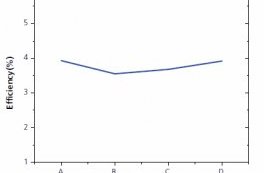
Polymer Semiconductors
Plextronics’ Plexcore® technology platform is comprised of semiconducting polymers and solution-processable inks that are designed to maximize the efficiency, lifetime and stability of PE devices. Plexcore OS, in particular, is a p-type organic semiconductor based on regioregular poly 3-hexylthiophene, RR-P3HT (Figure 1), a semi-crystalline, semiconducting polymer with exceptional spectroscopic and electronic properties. The material is easily synthesized via a method developed Plextronics’ co-founder, Dr. Richard D. McCullough. Plexcore OS 2100 (Aldrich Prod. No. 698997) is a grade of P3HT specifically designed for OPV and demonstrates the following properties:
Figure 1 Poly 3-hexylthiophene (Aldrich Prod. Nos. 698997, 698989)
- Electronics grade purity ( 7% cell efficiencies will require tailoring of all of these properties in combination.
 o the best performance of organic solar cells for commercial applications. Plextronics is actively pursuing development of higher efficiencies with the Plexcore PV platform. NREL-certified efficiencies in excess of 5% have already been achieved with improvements in materials and morphology.
o the best performance of organic solar cells for commercial applications. Plextronics is actively pursuing development of higher efficiencies with the Plexcore PV platform. NREL-certified efficiencies in excess of 5% have already been achieved with improvements in materials and morphology.
Table 1 Factors Influencing OPV Effi ciency
Polymer Conductors
Regioselective polymerization techniques used for synthesizing P3HT allow fine control of the absolute structure of the polymeric materials which support a variety of functionalities, thus enabling a greatly expanded platform for polymer design. For example, Plextronics has developed an inherently doped sulfonated solution of Poly(thiophene-3-[2-(2-methoxyethoxy) ethoxy]-2, 5-diyl) (see Figure 7).
 IL) for OLED devices and as a hole transport layer (HTL) for OPV devices. Plextronics provides 2% concentration solutions for application as an HIL - Plexcore OC 1100 (Aldrich Prod. No. 699799) and Plexcore® OC 1200 (Aldrich Prod. No. 699780).
IL) for OLED devices and as a hole transport layer (HTL) for OPV devices. Plextronics provides 2% concentration solutions for application as an HIL - Plexcore OC 1100 (Aldrich Prod. No. 699799) and Plexcore® OC 1200 (Aldrich Prod. No. 699780).Figure 7 Poly(thiophene-3-[2-(2-methoxyethoxy)ethoxy]-2, 5-diyl), sulfonated (Aldrich Prod. Nos. 699799, 699780)
Some of the performance benefits that Plexcore® OC offers as an HIL include:
- Reduced acidity, preventing anode degradation and ensuring improved device lifetime.
- Tunable properties such as work function, resistivity, surface energy, and viscosity, enabling researchers to optimize device performance.
- Compatible with multiple solvent systems and aqueous-based solutions, facilitating a variety of processing techniques.











